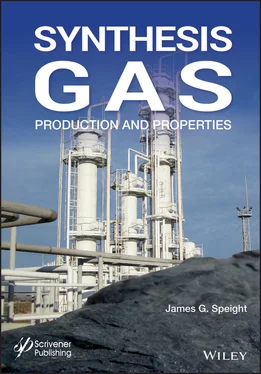1 ...7 8 9 11 12 13 ...42 The United States has vast known oil shale resources that could translate into as much as 2.2 trillion barrels of known oil -in-place . Oil shale deposits in the United States are concentrated mainly in the Green River Formation in the states of Colorado, Wyoming and Utah, which account for nearly three-quarters of this potential (Lee, 1990; Scouten, 1990; Lee, 1991; Bartis et al. , 2005; Andrews, 2006; Speight, 2008; 2012). Because of the abundance and geographic concentration of the known resource, oil shale has been recognized as a potentially valuable United States energy resource since as early as 1859, the same year Colonel Drake completed his first oil well in Titusville, Pennsylvania ( Chapter 1). Early products derived from shale oil included kerosene and lamp oil, paraffin, fuel oil, lubricating oil and grease, naphtha, illuminating gas, and ammonium sulfate fertilizer.
Since the beginning of the 20 thcentury, when the United States Navy converted its ships from coal to fuel oil, and the economy of the United States was transformed by gasoline-fueled automobiles and diesel-fueled trucks and trains, concerns have been raised related to assuring adequate supplies of liquid fuels at affordable prices to meet the growing needs of the nation and its consumers. Thus, it is not surprising that the abundant resources of oil shale in the United States were given consideration as a major source for these fuels. In fact, the Mineral Leasing Act of 1920 made crude oil and oil shale resources on federal lands available for development under the terms of federal mineral leases. This enthusiasm for oil shale resources was mitigated to a large extent by the discoveries of more economically producible and easy-to-refine liquid crude oil in commercial quantities, which caused the interest in oil shale to decline markedly.
However, the interest in oil shale resumed after World War II, when military fuel demand and domestic fuel rationing and rising fuel prices made the economic and strategic importance of the oil shale resource more apparent. After the war, the booming postwar economy drove demand for fuels ever higher, starting with the commencement of the development, in 1946, of the Anvil Point, Colorado, oil shale demonstration project by the United States Bureau of Mines. Significant investments were made by commercial companies to define and develop the US oil shale resource and to develop commercially viable technologies and processes to mine, produce, retort, and upgrade oil shale into viable refinery feedstocks and by-products. Once again, however, major crude oil discoveries in the lower-48 United States, off-shore, and in Alaska, as well as other parts of the world, reduced the foreseeable need for shale oil and interest and associated activities again diminished.
By 1970, oil discoveries were slowing, demand was rising, and crude oil imports into the United States, largely from the Middle Eastern oil-producing nations, were rising to meet demand. Global oil prices, while still relatively low, were also rising, reflecting the changing market conditions. Ongoing oil shale research and testing projects were reenergized and new projects were envisioned by numerous energy companies seeking alternative fuel feedstocks (Speight, 2008, 2011c). These efforts were significantly amplified by the impact of the 1973 Arab oil embargo which demonstrated the vulnerability of the oil-consuming nations, particularly the United States, to oil import supply disruptions, and were underscored by a new supply disruption associated with the 1979 Iranian Revolution.
By 1982, however, technology advances and new discoveries of offshore oil resources in the North Sea and other bodies of water provided new sources for oil imports into the United States. Thus, despite significant investments by energy companies, numerous variations and advances in mining, restoration, retorting, and in-situ processes, the costs of oil shale production relative to current and foreseeable oil prices, made continuation of most commercial efforts impractical.
Despite the huge resources, oil shale is an underutilized energy resource. In fact, one of the issues that arise when dealing with fuels from oil shale is the start-stop-start episodic nature of the various projects. The projects have varied in time and economic investment and viability. The reasons comprise competition from cheaper energy sources, heavy front-end investments and, of late, an unfavorable environmental record. Oil shale has, though, a definite potential for meeting energy demand in an environmentally acceptable manner (Bartis et al. , 2005; Andrews, 2006; Speight, 2020).
Biomass is a renewable resource that has received considerable attention due to environmental considerations and the increasing demands of energy worldwide (Brown, 2003; NREL 2003; Wright et al. , 2006; Tsai et al. , 2007; Speight, 2008; Langeveld et al. , 2010; Speight, 2011c; Lee and Shah, 2013; Hornung, 2014). Biomass is produced by a photosynthetic process (photosynthesis) which involves chemical reactions occurring on the Earth between sunlight and green plants within the plants in the form of chemical energy. In the process, solar energy is absorbed by green plants and some microorganisms to synthesize organic compounds from low-energy carbon dioxide (CO 2) and water (H 2O). For example,

The general formula of the organic material produced during photosynthesis process is (CH 2O) nwhich is mainly carbohydrate material. Some of the simple carbohydrates involved in this process are the simple carbohydrates glucose (C 6H 12O 6) and sucrose (C 12H 22O 11) and constitute biomass, which is a renewable energy source due to its natural and repeated occurrence in the environment in the presence of sunlight. The amount of biomass that can be grown certainly depends on the availability of sunlight to drive the conversion of carbon dioxide and water into carbohydrates. In addition to limitations of sunlight, there is a limit placed by the availability of appropriate land, temperature, climate and nutrients, namely nitrogen, phosphorus and trace minerals in the soil.
Biomass is clean for it has negligible content of sulfur, nitrogen and ash, which give lower emissions of sulfur dioxide, nitrogen oxides and soot than conventional fossil fuels. Biomass resources are many and varied, including (i) forest and mill residues, (ii) agricultural crops and waste, (iii) wood and wood waste, (iv) animal waste/s, (v) livestock operation residues, (vi) aquatic plants, (vii) fast-growing trees and plants, (viii) municipal waste, and (ix) and industrial waste. The role of wood and forestry residues in terms of energy production is as old as fire itself and in many societies wood is still the major source of energy. In general, biomass can include anything that is not a fossil fuel that is based on bio-organic materials other than natural gas, crude oil, heavy crude oil, extra heavy crude oil and tar sand bitumen (Lucia et al. , 2006; Speight, 2008, 2011c; Lee and Shah, 2013).
There are many types of biomass resources that can be used and replaced without irreversibly depleting reserves and the use of biomass will continue to grow in importance as replacements for fossil fuel sources and as feedstocks for a range of products (Narayan, 2007; Speight, 2008, 2011c; Lee and Shah, 2013). Some biomass materials also have particular unique and beneficial properties which can be exploited in a range of products including pharmaceuticals and certain lubricants. In this context, the increased use of biofuels should be viewed as one of a range of possible measures for achieving self-sufficiency in energy, rather than a panacea to completely replace the fossil fuels (Crocker and Crofcheck, 2006; Worldwatch Institute, 2006; Freeman, 2007; Nersesian, 2007).
Читать дальше













